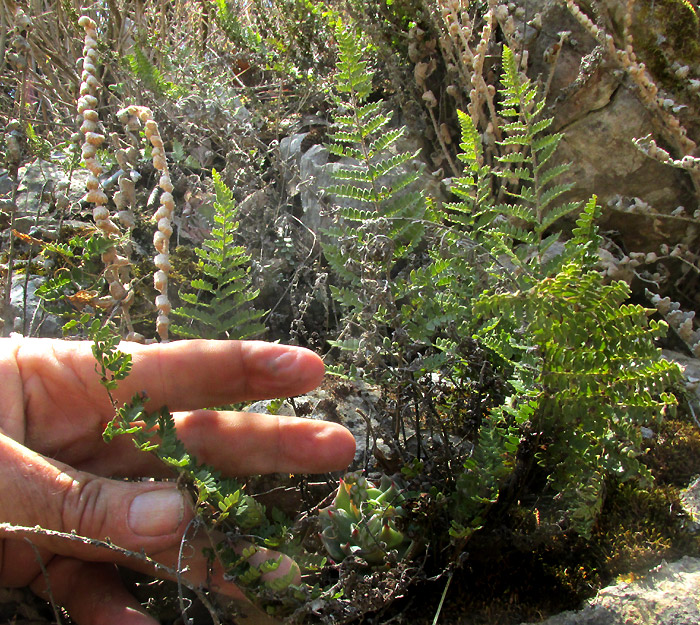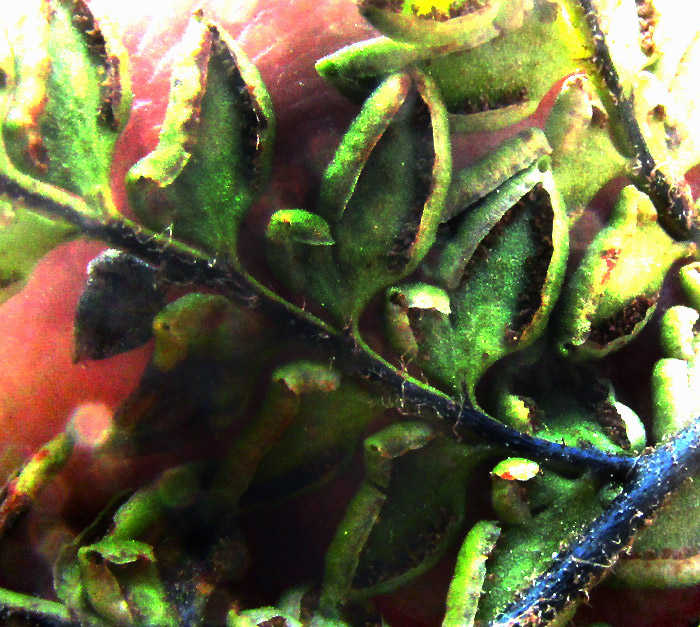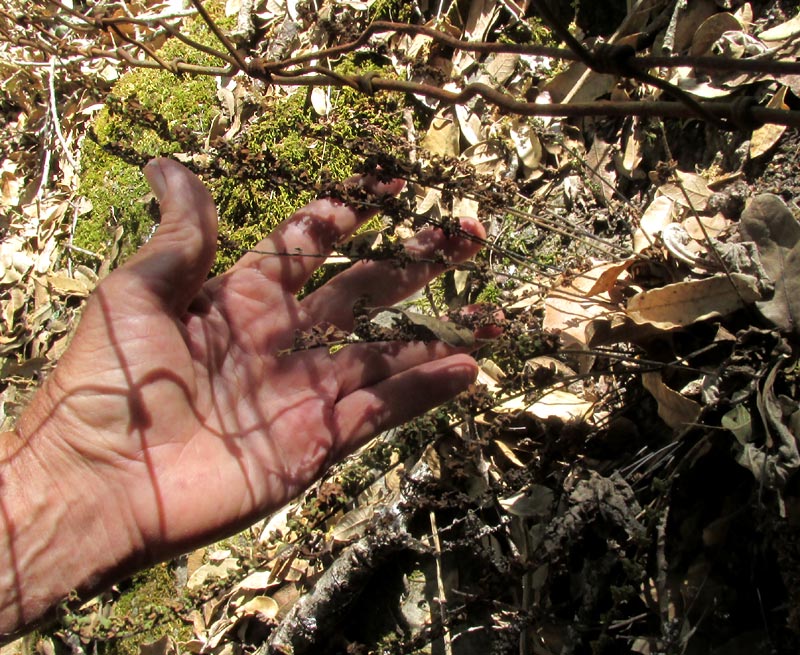Excerpts from Jim Conrad's
Naturalist Newsletter
entry from field notes dated May 6, 2023, on small gravel road descending into valley east of Curva de la Doctorcilla, which is on the road connecting Hwy120 and El Doctor; oak, pine and juniper forest on limestone bedrock; elevation ±2650m (8700 ft); Eastern Sierra Madre mountains of east-central Querétaro state, MÉXICO, (N20.88°, W99.62°)
ROYAL LIPFERN

Here at the end of a long dry season, among limestone rocks exposed along the road's edge, the above green ferns weren't as crumpled, dried up and gray as the slender, sky-pointing, much more commonly occurring Hybrid Cloakfern seen rising behind them. From a distance, lots of fern species look like these green ones so, to identify them, you need to "do the botany."

A closer look showed that the fronds were twice-pinnate -- primary blade divisions called pinnae themselves were divided into units called pinnules. Moreover, the pinnules were of an interesting shape, basically egg-shaped, but varying in shape from the bottom ones closest to the stem main stem, or rachis, to the tip ones.

In fern identification few features are more diagnostic than the manner by which the spore-producing sporangia are arranged. In the above picture, each of the tiny, grainy, brown items mostly hidden by the turned-under blade surfaces is a sporangium containing spores. Sporangia sheltering beneath down-curving pinnule margins signals that of the several fern families, this species is a member of the Maidenhair Fern Family, the Pteridaceae.
In our part of upland central Mexico, if you have a member of that family with twice-pinnate fronds, black, hairy stems as seen above, and the sporangia peep in the manner seen above, from beneath curved-under pinnule margins, you have a lipfern. Moreover, if your lipfern's turned-under margins are of the same texture and color as the rest of the pinnule, the petioles are covered with both slender hairs and broad-based, hairlike scales, as seen in the above photo, and pinnules at the bottom of each pinna develop single lobes as seen on the above picture, you have the Royal Lipfern, HEMIONITIS NOTHOLAENOIDES.
As is documented in the next section, we've seen this fern before, but then it was so dried up and shriveled that details seen above were hard to make out. More is said about the lipferns' messy taxonomy, which a year after that was written, still holds true today.
entry from field notes dated April 15, 2022, taken in disturbed/reforesting borderline cloudforest within 1km of Valle de los Fantasmas, elevation ±2,320m (7600 ft), with limestone bedrock; about 40kms (24 miles), straight-line, ESE of San Luis Potosí, San Luis Potosí state, MÉXICO, (N22.06°, W100.62°)
ROYAL LIPFERN, DRIED UP

Along a one-lane dirt road following the valley floor, a roadcut had been made, leaving a low but steeply sloped, usually tree-shaded, moss-covered dirt wall facing north. Beneath a wire fence strung on the wall-slope and at the base of a tree's exposed big roots, a fern was in its dried-up, brown, shriveled, late dry season mode, shown above.
The fern was so crumpled that at first it seemed pointless to try to identify it. However, with a hand lens, some of its brown, grainy sporangia could be seen, shown below:

Instead of being clustered in distinct spots across the frond's undersurface, in separate sori, or fruit-dots, as in many fern species, these sporangia gathered along the frond's curled-under rim. The curled rim protected sporangia as cellophane-like indusia do for many sori on other species. In the above picture, each tiny, spherical, brown item is a sporangium containing spores which escape into the air or water when the sporangium cracks open.
This fern's manner of producing sporangia beneath underturned frond edges told me that the species belonged to one of about 21 fern families, and that's the Maidenhair Fern Family, the Pteridaceae. However, this wasn't a maidenhair fern. The frond's general form, size and habitat all strongly suggested the big genus whose species commonly are known as lip ferns, because of the frond margin's underturned "lips," the genus Cheilanthes.*
Knowing I'd be using that Lip Fern key and needing all the information I could gather, another picture was taken of the fern's curled-under frond tip, shown below:

Here are key field marks used during the identification process:
All these features and more lead me to what's sometimes called the Royal Lipfern. It's CHEILANTHES {HEMIONITIS} NOTHOLAENOIDES. It bears an English name because it's distributed from the southern US and the Caribbean south to Argentina. Along with its vast area of distribution, it displays plenty of habitat variability, from slopes and canyons to oak, oak-pine, pine, fir and cedar forests and desert scrub, mostly on limestone soils but also on soils derived from igneous rock, and other soil types, from 1000-3150 meters in elevation (3300-10,300ft). Such an adaptable species might well turn up in a sheltered valley in an oak-pine zone.